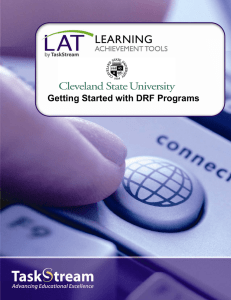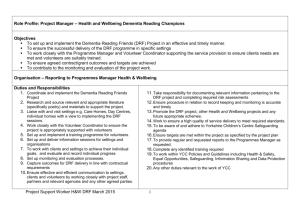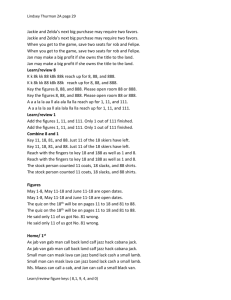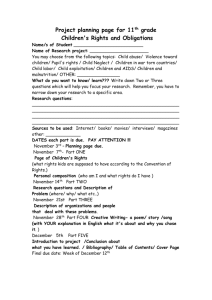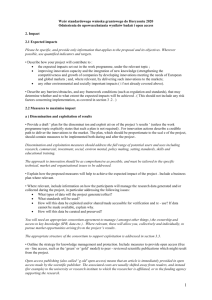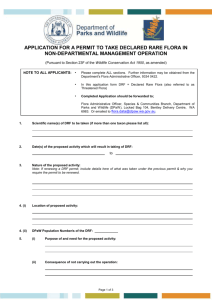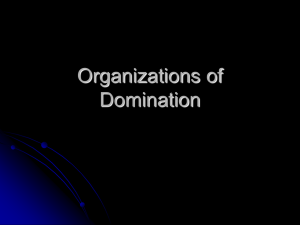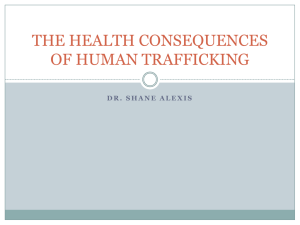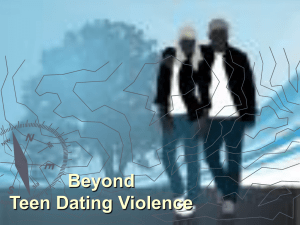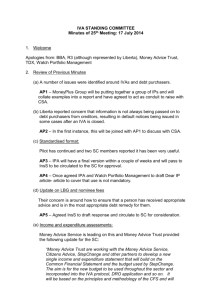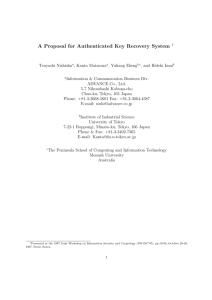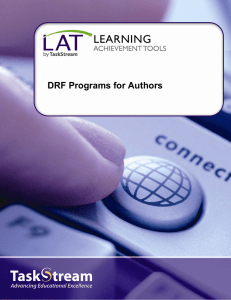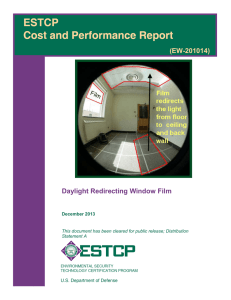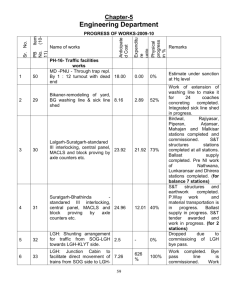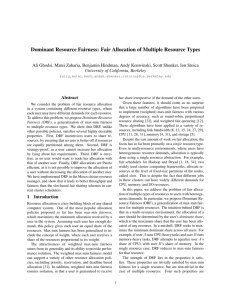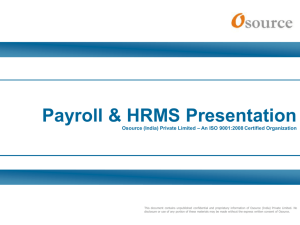Child Protection Compliance Standards for Contractors and NGOs
advertisement
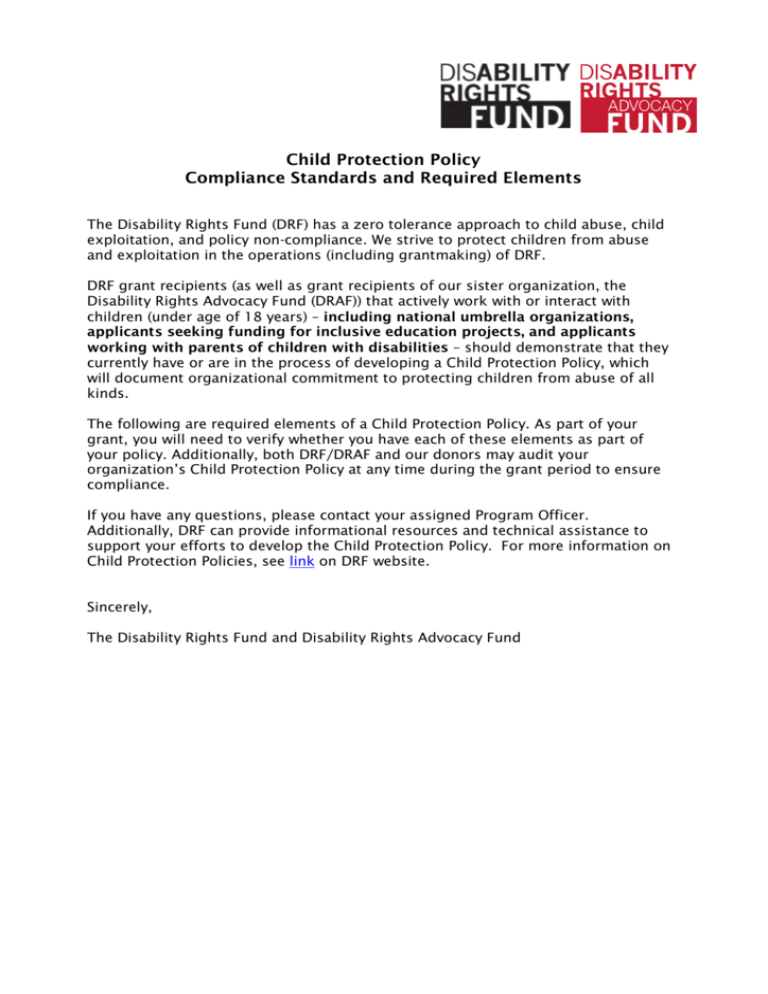
Child Protection Policy Compliance Standards and Required Elements The Disability Rights Fund (DRF) has a zero tolerance approach to child abuse, child exploitation, and policy non-compliance. We strive to protect children from abuse and exploitation in the operations (including grantmaking) of DRF. DRF grant recipients (as well as grant recipients of our sister organization, the Disability Rights Advocacy Fund (DRAF)) that actively work with or interact with children (under age of 18 years) – including national umbrella organizations, applicants seeking funding for inclusive education projects, and applicants working with parents of children with disabilities – should demonstrate that they currently have or are in the process of developing a Child Protection Policy, which will document organizational commitment to protecting children from abuse of all kinds. The following are required elements of a Child Protection Policy. As part of your grant, you will need to verify whether you have each of these elements as part of your policy. Additionally, both DRF/DRAF and our donors may audit your organization’s Child Protection Policy at any time during the grant period to ensure compliance. If you have any questions, please contact your assigned Program Officer. Additionally, DRF can provide informational resources and technical assistance to support your efforts to develop the Child Protection Policy. For more information on Child Protection Policies, see link on DRF website. Sincerely, The Disability Rights Fund and Disability Rights Advocacy Fund Required Elements of Child Protection Policies PART I: CHILD PROTECTION POLICY Minimum Elements of Child Protection Policy Included in Child Protection Policy? (Please respond with Yes or No) POLICY: Policy applies to all personnel, partners, volunteers, and subcontractors that are engaged by your organization to perform any part of DRF/DRAFfunded activity CHILD-SAFE RECRUITMENT AND SCREENING: Organization has robust recruitment screening process for all personnel in contact with children, including: Verbal referee checks; Interviews that incorporate behavioral-based interview questions1. Criminal record checks before hire. COMPLAINTS MANAGEMENT: Policy includes documented reporting procedure for child exploitation and abuse allegations and policy for non-compliance, including actions to be taken when exploitation, abuse or non-compliance occur. TRAINING: Organization provides child protection training for personnel. CODE OF CONDUCT: Organization has a child protection code of conduct that meets the minimum standard set by DRF/DRAF (see below). COMMITMENT TO CHILD PROTECTION: Policy commits the organization to preventing a person from working with children if they pose an unacceptable risk to children. EMPLOYMENT CONTRACTS: Organization’s employment contracts contain provisions for dismissal, suspension, or transfer to other duties for any employee who breaches the child protection code of conduct. REVIEW: Policy is subject to regular review – at least every five years or earlier if warranted. RISK ASSESSMENT: Organization undertakes a risk assessment that covers all DRF/DRAFfunded activities where there is contact with children. The assessment should identify risks, classify any high-risk activities, and document steps being taken to reduce or remove these risks. ENDORSEMENT: The CPP is approved and endorsed by the relevant management body (i.e. board of directors, executive staff, committee). Behavioral-based questions are used when candidates are applying for employment. Questions are designed to understand how candidates handled past experiences in order to determine whether the person has the skills and experiences necessary for the job. In relation to the Child Protection Policy recruitment, questions would be designed to understand candidates’ experiences working with children. 1 PART II: CODES OF CONDUCT Minimum Elements of Codes of Conduct Organization agrees to incorporate the following elements into Codes of Conduct that any personnel, partners, volunteers, or subcontractors will sign at outset of the DRF/DRAF-funded project: I will treat children with respect regardless of race, color, gender, language, religion, political or other opinion, national, ethnic or social origin, property, disability, birth or other status I will not use language or behavior towards children that is inappropriate, harassing, abusive, sexually provocative, demeaning or culturally inappropriate I will not engage children under the age of 18 in any form of sexual intercourse or sexual activity, including paying for sexual services or acts Wherever possible, I will ensure that another adult is present when working in the proximity of children I will not invite unaccompanied children into my home, unless they are at immediate risk of injury or in physical danger I will not sleep close to unsupervised children unless absolutely necessary, in which case I must obtain my supervisor’s permission, and ensure that another adult is present if possible I will use any computers, mobile phones, video cameras, cameras or social media appropriately, and never to exploit or harass children or access child exploitation material through any medium I will not use physical punishment on children I will not hire children for domestic or other labor which is inappropriate given their age or developmental stage, which interferes with their time available for education and recreational activities, or which places them at significant risk of injury I will comply with all relevant national and local legislation, including labor laws in relation to child labor I will immediately report concerns or allegations of child exploitation and abuse and policy non-compliance in accordance with appropriate procedures I will immediately disclose all charges, convictions and other outcomes of an offense, which occurred before or occurs during association with organization that relate to child exploitation and abuse. When photographing or filming a child or using children’s images for work-related purposes, organization must: assess and endeavor to comply with local traditions or restrictions for reproducing personal images before photographing or filming a child obtain informed consent from the child and a parent or guardian of the child before photographing or filming a child. As part of this, the organization must explain how the photograph or film will be used ensure photographs, films, videos and DVDs present children in a dignified and respectful manner and not in a vulnerable or submissive manner. Children should be adequately clothed and not in poses that could be seen as sexually suggestive Included in Child Protection Policy? (Yes/No) ensure images are honest representations of the context and the facts ensure file labels, meta data or text descriptions do not reveal identifying information about a child when sending images electronically or publishing images in any form Persons associated with organization agree to use common sense and avoid actions or behaviors that could be construed as child exploitation and abuse.
